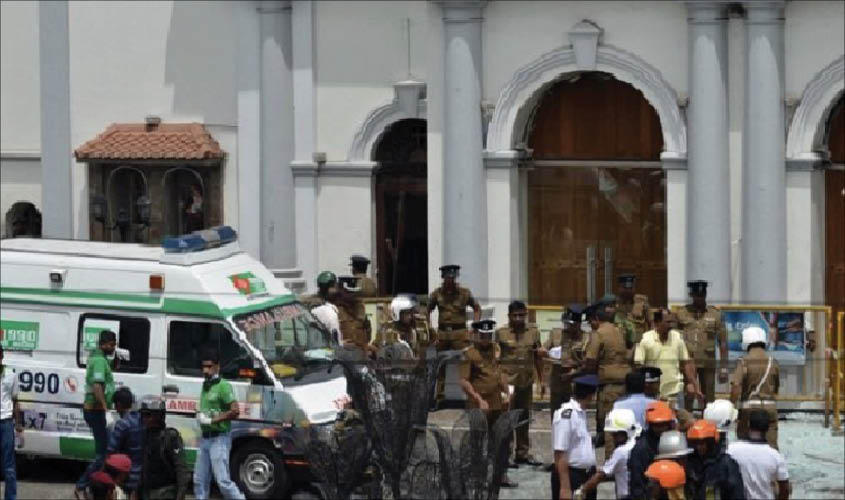ISIS considers South Asia a fertile ground for its organisation because of the region’s history of jihadist insurgency and high density Muslim population.
The serial bomb blasts in Sri Lanka in which around 250 people including 38 foreigners were killed and nearly 500 injured is by far the deadliest terror attack in South Asia by a home grown terror module inspired by the ISIS. While the Sri Lankan authorities are at a loss to explain the motive behind such a dastardly and barbaric act, the involvement of middle class, well educated, financially well off and socially well entrenched locals including a woman fidayeen is indicative of a global pattern in pan-Wahhabi extremism.
It proves that education and career have little or no importance for a jihadi terrorist intoxicated by jihadi radicalism. While one of the nine perpetrators of this heinous crime against humanity had studied in the UK, two of them were brothers hailing from a wealthy Colombo spice trading family. Another man was a firebrand cleric and a person known as Inshaf Ahmad Ibrahim was the alleged mastermind. The ISIS has even released their images in which all of them are holding knives. And none adhering to this extremist ideology is apologetic for what has happened.
In fact ISIS considers South Asia a fertile ground for its organisation. The history of jihadist insurgency, high density Muslim population and growing tensions between communities have prompted it to focus on the region in its quest for expansion. ISIS may be down but not out is proven more than once.
In 2016, ISIS’ India connect became a national headline when 21 people, including women and children from Kerala went missing. Most of the youth who went missing were educated professionals including doctors and engineers hailing from middle or upper middle class families. They left their cushy jobs and homely comforts to join the ISIS network both within and outside the country, thereby nullifying the argument that lack of education and poverty drive extremist ideas among the Muslim youth.
As things are, both South Asia and Indian Ocean hold great strategic importance for ISIS and pan-Wahhabi fundamentalists all over. Control over them will not only help in resource generation but also controlling navigation routes. Hence, it is not just Colombo or Sri Lanka but the Indian Ocean that they are after.
As such the ISIS’ ultimate objective is to establish Wahhabi rule or Caliphate all over the world, for which it needs entry points from the seas. Then the obvious question is why not Indian sea coast? Even Indian sea coast must be on their target, with important Indian seaports and docks as their next target. However, the important thing to note is that the Indian sea cost may give extensive area but not depth, whereas Sri Lanka provides the strategic depth which India does not.
Therefore, the Lankan attack should be viewed as part of the global strategy by the ISIS to re-establish and re-locate itself as the umbrella institution of all jihadi elements and launch joint terror attacks on chosen targets.
As such it is often argued that Indian Ocean is not India’s ocean alone, as there are Indian, US, Australian and even Pakistani fleets sailing there. Therefore, control over Indian Ocean could give them access to these fleets and room for strategic planning to carry out terror attacks utilising Pakistani vessels as they have been using its land to wage jihad. After all, Pakistan’s involvement in aiding and abetting jihadi terrorism is well documented, from giving shelter to Osama Bin Laden in Abbottabad to terror attack on Indian troops in Pulwama.
Even New Zealand being on the Pacific has its own strategic importance for the ISIS and may be, it can be safely surmised, that the condemnable incident of Christchurch happened because someone driven by Islamophobia was paranoid about such strategic misuse of New Zealand. Hence, the Lankan attack, which is also seen as a bid to avenge the Christchurch mosque attack, should not be dismissed as a religious frenzy alone. Religious frenzy may be a superficial part of it. The undercover part is strategic control for ISIS through a Wahhabi terrorist group, the National Thowheeth Jama’ath.
However, this is a warning of the things to come in future if ISIS and its pan-Wahhabi fundamentalist extremist ideology are not checked effectively. As of now, ISIS is slowly and steadily spreading its wings. Taking a lesson from the history of Islamic expansion across the seas to distant continents from Asia to Africa and from there to Europe, may be the ISIS is now eyeing a Wahhabi fleet and Wahhabi base dedicated only to radical Wahhabi activities.
A weak democracy, internal political turmoil, ethnically divided population but immense natural resources and optimum infrastructure make Sri Lanka an ideal island for this, unlike Maldives, which is scattered and thinly populated, with scarce resources. Today it may seem a bit far-fetched but, as of now, Sri Lanka is the most easily controllable in Indian Ocean, despite indirect presence of China at Hambantota. For one thing is loud and clear that China might be doing anything with Uyghur insurgents in Xinjiang, it is consciously protecting and thereby supporting Masood Azhar and the Wahhabi fundamentalist ideology.

